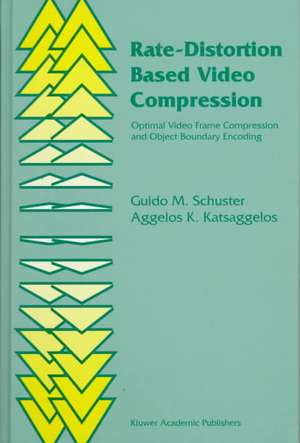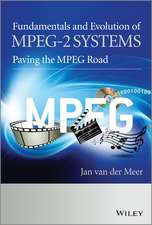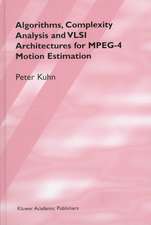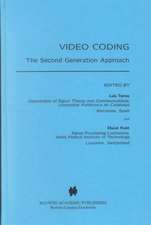Rate-Distortion Based Video Compression: Optimal Video Frame Compression and Object Boundary Encoding
Autor Guido M. Schuster, Aggelos Katsaggelosen Limba Engleză Hardback – 30 dec 1996
| Toate formatele și edițiile | Preț | Express |
|---|---|---|
| Paperback (1) | 987.82 lei 6-8 săpt. | |
| Springer Us – 6 dec 2010 | 987.82 lei 6-8 săpt. | |
| Hardback (1) | 996.40 lei 6-8 săpt. | |
| Springer Us – 30 dec 1996 | 996.40 lei 6-8 săpt. |
Preț: 996.40 lei
Preț vechi: 1245.50 lei
-20% Nou
Puncte Express: 1495
Preț estimativ în valută:
190.69€ • 198.34$ • 157.42£
190.69€ • 198.34$ • 157.42£
Carte tipărită la comandă
Livrare economică 15-29 aprilie
Preluare comenzi: 021 569.72.76
Specificații
ISBN-13: 9780792398509
ISBN-10: 0792398505
Pagini: 288
Ilustrații: XX, 288 p.
Dimensiuni: 155 x 235 x 24 mm
Greutate: 0.68 kg
Ediția:1997
Editura: Springer Us
Colecția Springer
Locul publicării:New York, NY, United States
ISBN-10: 0792398505
Pagini: 288
Ilustrații: XX, 288 p.
Dimensiuni: 155 x 235 x 24 mm
Greutate: 0.68 kg
Ediția:1997
Editura: Springer Us
Colecția Springer
Locul publicării:New York, NY, United States
Public țintă
ResearchDescriere
One of the most intriguing problems in video processing is the removal of the redundancy or the compression of a video signal. There are a large number of applications which depend on video compression. Data compression represents the enabling technology behind the multimedia and digital television revolution. In motion compensated lossy video compression the original video sequence is first split into three new sources of information, segmentation, motion and residual error. These three information sources are then quantized, leading to a reduced rate for their representation but also to a distorted reconstructed video sequence. After the decomposition of the original source into segmentation, mo tion and residual error information is decided, the key remaining problem is the allocation of the available bits into these three sources of information. In this monograph a theory is developed which provides a solution to this fundamental bit allocation problem. It can be applied to all quad-tree-based motion com pensated video coders which use a first order differential pulse code modulation (DPCM) scheme for the encoding of the displacement vector field (DVF) and a block-based transform scheme for the encoding of the displaced frame differ ence (DFD). An optimal motion estimator which results in the smallest DFD energy for a given bit rate for the encoding of the DVF is also a result of this theory. Such a motion estimator is used to formulate a motion compensated interpolation scheme which incorporates a global smoothness constraint for the DVF.
Cuprins
1 Introduction.- 2 Review of Lossy Video Compression.- 3 Background.- 4 General Contributions.- 5 Optimal Motion Estimation and Motion Compensated Interpolation for Video Compression.- 6 A Video Compression Scheme with Optimal Bit Allocation Between Displacement Vector Field and Displaced Frame Difference.- 7 A Video Compression Scheme with Optimal Bit Allocation Among Segmentation, Motion and Residual Error.- 8 An Optimal Polygonal Boundary Encoding Scheme.- References.


















